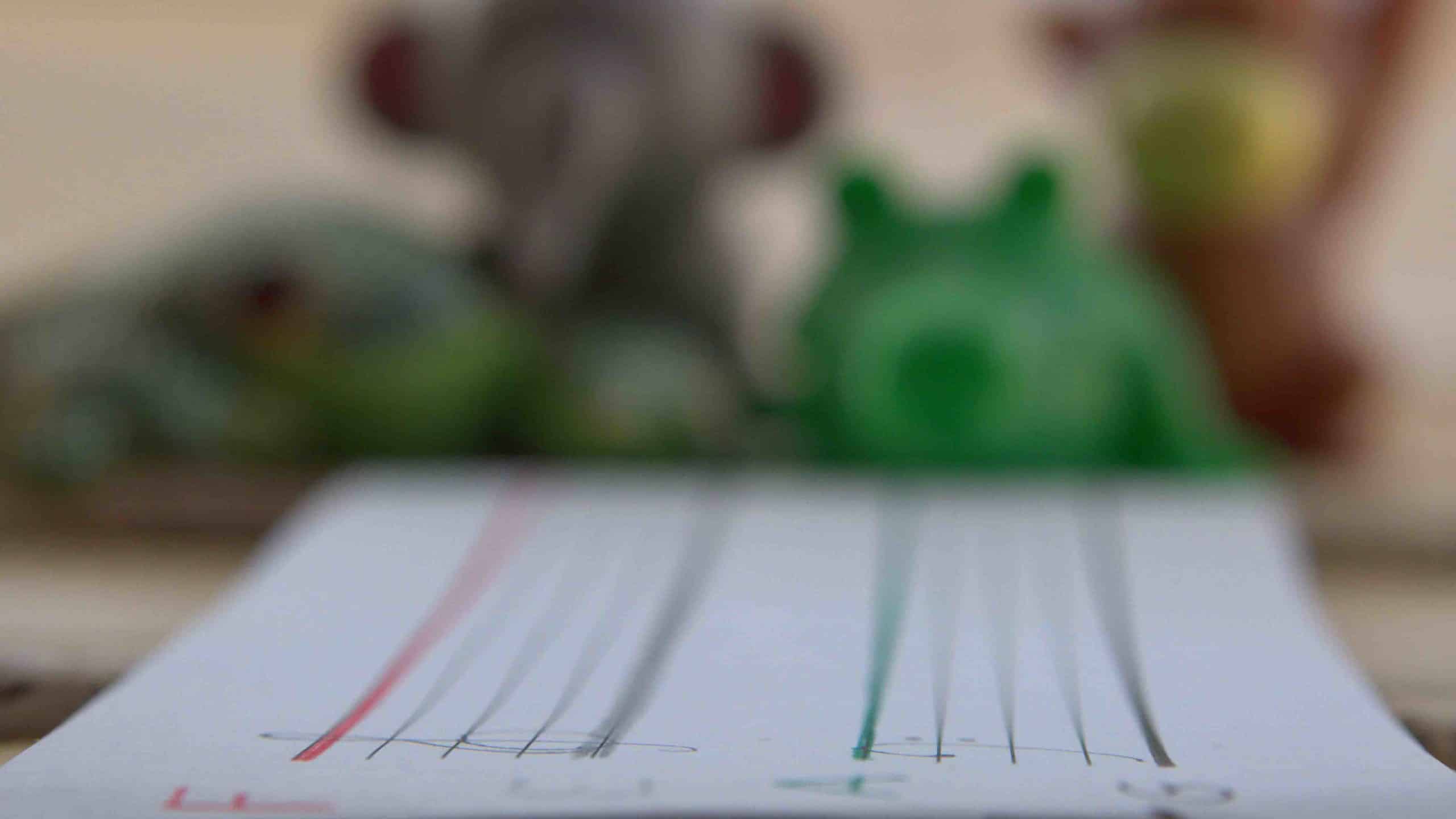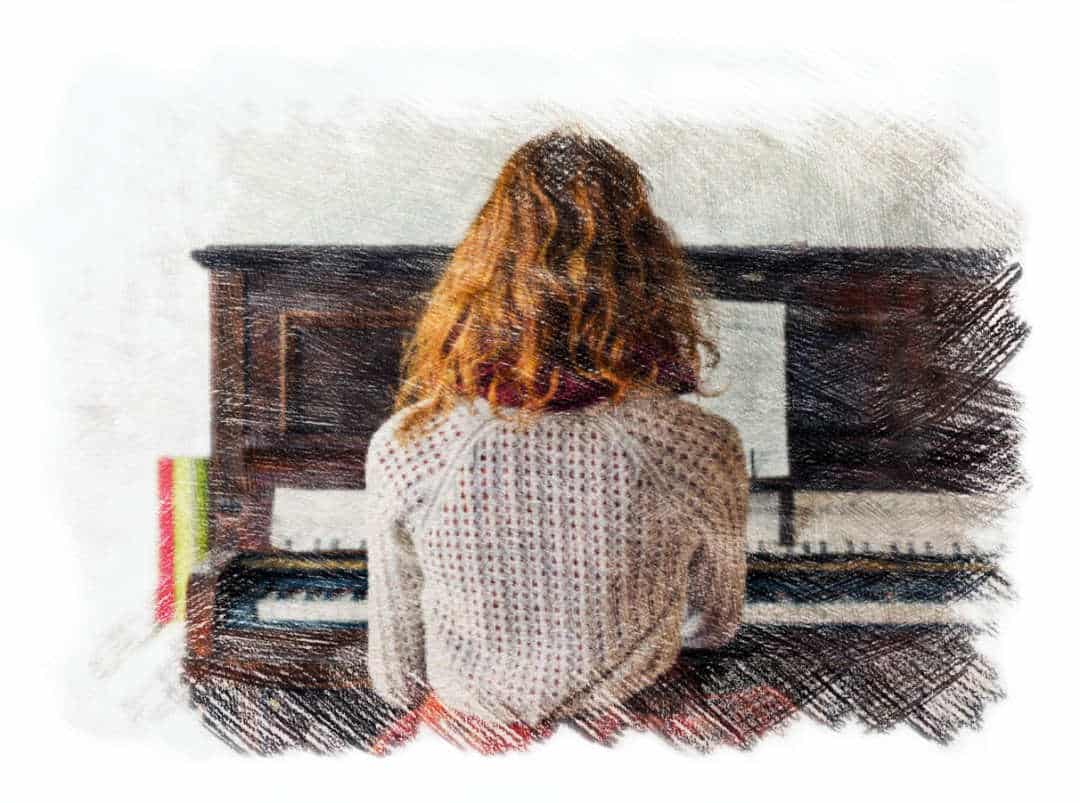The Visual Approach to Sight-Reading

The Visual Approach to Sight-Reading
When reading sheet music, a lot of children find it difficult to remember what the different notes on the clef are. A widely used method to memorise notes on the clef involves designating a letter to each line and each space which makes up a word and a sentence:
Treble clef:
FACE (all the notes in a space)
Every Good Boy Deserves Fun (all the notes on a line)
Bass clef:
All Cows Eat Grass (all the notes in a space)
Good Burritos Don’t Fall Apart (all the notes on a line)
But this method does not teach students how to think for themselves, see the pattern in the sheet music and figure out the other notes by using steps and skips. In other words, it does not teach them how to learn. It only teaches them facts. Still, for a lot of children, this is a way of learning notes that they find easy to use, so it would be wrong to stop using it completely. Instead, we will introduce another method that the student and teacher can use alongside the traditional method. This will equip students with an alternative way of finding more difficult notes when they need to. Some children might also find the new method easier. The most important reason for introducing a new method is to give the students different ways of learning the same thing and that way learn it on a deeper level.
The new method we are introducing involves memorising the bottom and top line of each clef. The idea is that you should always know these four lines as four strongly established facts, and then you can easily work out everything else from these established notes.
For children, it is easier to remember these four notes as four animals. The four animals are as follows:
Treble clef
Top line – Frog
Bottom line – Elephant
Bass clef
Top line – Alligator
Bottom line – Gorilla
For young students, the tutor will go through the treble clef with them first. In most cases, the tutor should make them remember the two first animals for a couple of weeks first since four animals might be too much, but this is entirely up to each individual student and their age. A lot of children have no problem remembering all four animals in one go, especially since it is a very visual and fun way of learning the notes.
We will now introduce two ways of explaining this to the students. One of them demands a strong ability for the student to visualise. This can be difficult for young children, but it would be the preferable method for the slightly older child as they would be encouraged to visualise and use their imagination.
For younger children and older children who find visualising difficult, it is better to use a set of toy animal figures.
Using Toy Animal Figures
The tutor should be equipped with a toy elephant, frog, gorilla and alligator. The first time the tutor introduce the animals to the child, it’s advisable that they make it into a fun event for them. The tutor can say that they have brought some friends with them today and that they have come to tell the student something important. Then the tutor picks the animals up from their bag one by one as they explain what they mean. They will also colour in some blank sheet music with the animals’ respective colours.
The Visualisation Method
The tutor asks the student to turn to their right and ask them to imagine that there is a big elephant standing in the middle of the floor. For the student to take benefit from this, it is important to make sure that they really see the elephant with their inner eye. The teacher can help with this by asking the student to visualise details such as the colour of the elephant, what it is doing while it is standing in the room, in what direction it is looking, and what sound it is making. The more both the teacher and the student can feel the presence of the animals in the room, the better.
Next up is the frog. The same approach that was used for the elephant should be used again here. In addition, the teacher could suggest to the student to visualise that the frog is standing on the elephant’s head. This will help them remember that the elephant is below the frog on the clef.
It is important that these two animals are on the student’s right-hand side as the notes these animals represent are played with the right hand.
If the tutor wants them to, the student can label the four appropriate keys on the piano with animal stickers if they find it really hard to remember the keys. These should then come off one by one over a period of a few weeks to encourage memorising them instead of relying on the stickers for too long.
NOTE: The colour of the animals the student visualises should preferably be the colours they have in reality. This is because it is easier to associate the animals to their correct colour, and it is also easier to remember. Furthermore, it is easier for the tutor if the colour matches the colours of the animal toys and the custom-made sheet music – Black, green, grey, red. But if the student insists on choosing different colours for the animals than these, the tutor should go with this to support their enthusiasm and creative choices.
When the tutor is going through the top and bottom line of the bass clef, they should go through the same process. This time, the student should turn their head to their left and visualise a gorilla and an alligator. This time, it might be best if the gorilla is sitting on a chair or on the floor against the wall with the alligator on its lap.
Now that these four notes have been established, the tutor will teach the student how to find all the other notes using “skips and steps”. Any note can be found by counting the steps and skips from the animal it is closest to. To avoid always going from the bottom or top line, it is advisable to develop a habit of using the last key that was played to find the next one.If this is a method the tutor would like their student to use, it should be practised a little bit in every lesson to ensure that the student remembers it and starts using the method independently. Every lesson, the tutor should take a few seconds and ask the children to visualise the animals standing in the same spot as before. If the student has not visualised the animals properly, it is likely that they will forget about them. If the tutor notices that this recurs lesson after lesson or that it takes a long time for the child to recall the animal, they might consider introducing them to the toy animals instead.
The tutor will explain to the student that they can use the alphabet to go up or down to figure out what note they can see on the clef. We are working on a visual way of doing this, but in the meantime, it is sufficient for the tutor to write the alphabet next to the clef they have coloured in with the animal’s colour. The alphabet should be written so that it ascends and descends in the same direction as the letters on the clef, like this:
G
F
E
D
C
B
A
The reason why this method should be used in addition to the “Every Good Boy Does Fine / FACE” method is because it is an active way of learning how to read music. In music education today, students are often taught the material passively, where the teacher simply tells them something they have to remember. We believe this is an archaic and ineffective form of teaching. Even though the modern world is a lot more fast-paced with a lot more to learn, we use a method of learning that was developed before we knew how the brain learns in the best way. Now that we know much more about how the brain learns best and that active learning is much more powerful than passively learning, it is time to update our learning and teaching methods and stop lagging behind like we are currently doing.
With the ‘four animals’ method, less time is spent on using a more passive method that does not further any other skills. Instead, the time is used more effectively by spending it on being engaged in a task that exercises the student’s logical thinking skills.
With the most popular existing method, you have to memorise 18 different notes:
FACE
Every Good Boy Deserves Fun
All Cows Eat Grass
Good Burritos Don’t Fall Apart
With the animal method, you only have to memorise 4:
Frog
Elephant
Alligator
Gorilla
Something the animal method gives you that is not possible with the other method is the possibility of finding notes that use ledger lines. If you have reached F (the top line of the treble clef), you can still find notes further up by using the same method of skips and steps.
This method is generally not difficult for children. What is difficult for them is being able to remember using it. When they struggle to find notes, they are probably struggling because they are not using this method. It is likely that they are not using any method. Often they will just try to memorise what that particular note is. As soon as the teacher reminds them of using the method, they often find the note straight away.
Some people use the “Every Good Boy Does Fine” method, which is perfect if they need to find one note or a starting note. But when they are going to find the note two skips above the line they have already played, they often go again from the beginning of the sentence to find the new note. This takes up a lot of time, and they are able to find the note a lot quicker by skipping two steps up.
When playing the other new notes apart from these four (Frog, Elephant, Alligator, Gorilla), they will become ingrained through repetition. This method is a way of increasing the rate of progress in the earliest stages of learning the piano, as well as getting a solid fundamental understanding of the basics. With time they are able to memorise more notes than just those four. This means that the four animals will at some point not be needed anymore and can be stopped being used.
Important:
We are not saying that you should only use the animal method, but that you should use it in addition to other methods.



